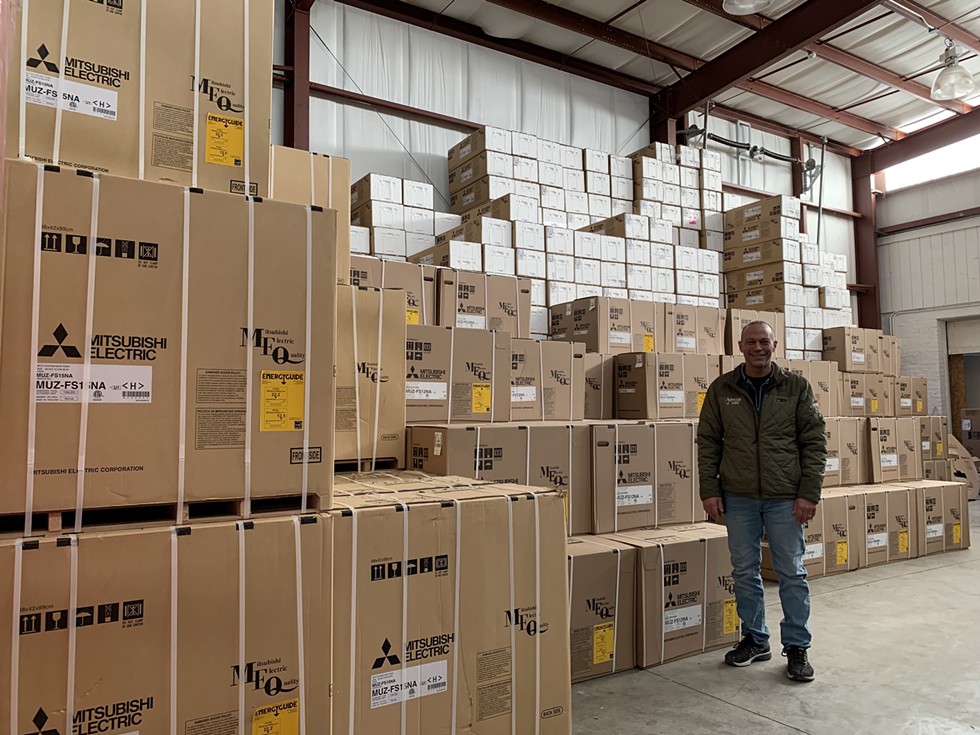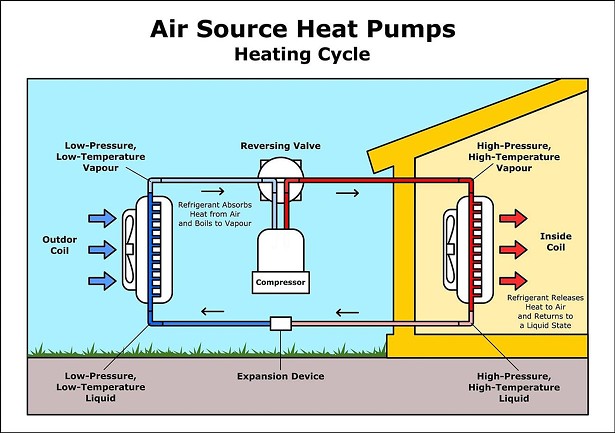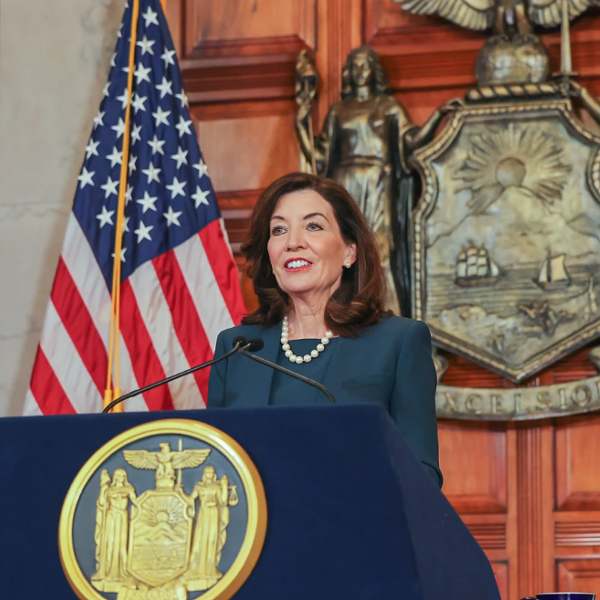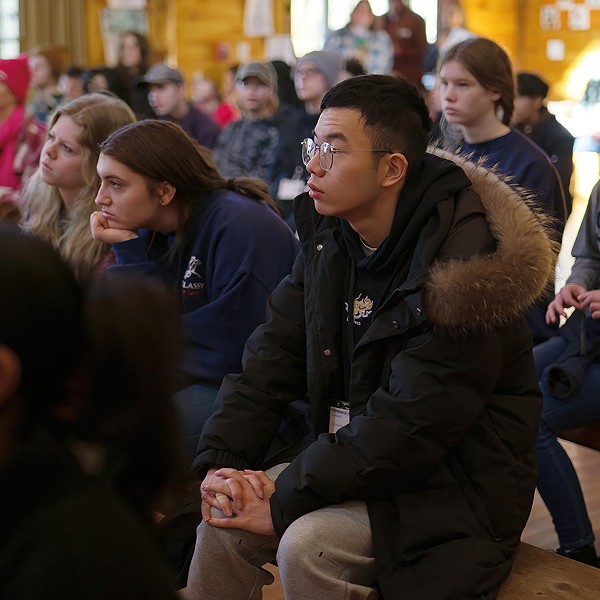If you want to see one of the world’s most potent weapons against climate change, you can pay a visit to North Chestnut Street in New Paltz, where Rycor HVAC has a warehouse full of them.
Scott Arnold, Rycor’s founder and owner, is a big believer in heat pumps. “This is absolutely what’s next,” he says. “Who wants to continue to burn fuel and have tanks and carbon dioxide in their house, and fires, and fire damage, and breathe in soot, and pay more for it? Who wants to do that forever? So this is going to be what’s next.”
Heat pumps have been Rycor’s sole business since 2006, and currently the company focuses on a single device: the Mitsubishi ductless mini-split. Arnold says his company is currently electrifying between six and eight homes a day in the Hudson Valley, many of them with help from a joint program between utility companies and the New York State Energy Research and Development Authority (NYSERDA) that partially subsidizes the cost of installation.
But although New York’s push for clean heat is intensifying, consumer subsidies for the kind of heat pump Rycor specializes in are dropping dramatically across the territories of three of New York’s electric utility companies: Con Edison, Orange & Rockland, and Central Hudson. In three others—NYSEG, Rochester Gas & Electric, and National Grid—the subsidies are unchanged, for now. To add to the confusion, each utility offers its own subsidy rate, and subsidies for some forms of heat pump technology are changing, while others—like ground source heat pumps, which are more expensive to install because they require excavation—are unchanged.
In Central Hudson’s territory, the subsidy for installing an air source heat pump system was set at $1,300 for every 10,000 BTUs per hour installed. As of March 1, it has dropped to $500—although if you get rid of your fossil fuel backup heating system completely as part of the project, the subsidy only falls to $1,000. Installation of heat pumps is fairly simple for a trained installer and a typical single-family home installation, but a cold-weather “mini-split” air source heat pump of the type Rycor uses might cost a few thousand dollars per unit just for the device itself, and require multiple devices to heat an entire house.
“They’re doing this at the worst possible time,” Arnold says. “It’s counterintuitive. They’re undoing a lot of good that a lot of people did. I don’t understand why it’s happening.”
Clean Heat: A Hot Commodity
New York’s Clean Heat Program was launched in 2020, in the wake of the passage of the 2019 Climate Leadership and Community Protection Act, the state’s sweeping climate law. According to a NYSERDA spokesperson, the program has an overall budget of $454 million, and is scheduled to run until 2025, or until the funding is exhausted.
In the Hudson Valley, the program is a victim of its own success. Initially created by an agreement between the utilities and the state Public Service Commission, the Clean Heat Program was launched with a fixed amount of funding to be spent on accelerating the adoption of clean heating and cooling technology. In the three utilities that are now lowering their subsidies, consumer adoption of heat pumps has gone faster than expected, and they are trying to stretch their pot of funding so it doesn’t run out before the program’s 2025 sunset date.
The March change is Central Hudson’s second reduction in the subsidy for air source heat pumps, after a smaller reduction in 2021. The program was “running really hot” throughout 2020 and early 2021, says Cory Scofield, a manager at Central Hudson. “We’re trying to encourage as much adoption of these heat pumps as possible, but we’re working within a fixed budget,” he says. “We realize it can be an uncomfortable exercise.”
The subsidy change is causing consternation for contractors and homeowners alike. Some homeowners who are pursuing heat pump projects didn’t know about the higher subsidy in time to take advantage of it. Many more are still unaware that it exists, or even that heat pumps do.
Manna Jo Greene, an Ulster County legislator and a longtime environmental advocate in the Hudson Valley, is dismayed that she missed the boat on a more generous subsidy for installing an air source heat pump system. Greene’s furnace died in November; thanks to an ultra-insulated house, she’s been able to make it through the winter with just a couple of space heaters, but she’s now looking to install a more permanent solution.
“I may have missed the opportunity,” she says. “I think it’s too bad, because we need to do as much as we possibly can in terms of addressing climate change.”
Meet the Heat Pump: Climate MVP
Based on practical principles of refrigeration, a heat pump doesn’t create heat, it just moves it from one place to another by shuttling it along a closed loop filled with refrigerant fluid. This enables it to keep energy inputs low; while high-efficiency gas heaters max out around 95 percent efficiency, a good heat pump can reach eye-popping efficiencies of more than 300 percent, drawing more energy from the air or the ground in the form of heat than it uses in electricity. In the summer, the same system works in reverse as an air conditioner.
Modern cold-weather heat pumps can draw heat from the air even at minus 15 degrees Fahrenheit, a temperature at which there is still a lot of heat energy in the air even though it might not feel like it to the human body. It sounds impossible, but it’s just physics.
“Cold doesn’t exist. The Tooth Fairy doesn’t exist. You can’t heat your house with the Tooth Fairy,” Arnold says with a grin.
Pioneered in the 1850s by Austrian inventor Peter von Rittinger, heat pump technology has roots in energy scarcity. Rittinger used it to harvest salt from ocean water in a region where that process was dependent on razing forests to burn them for heat. A century later, British engineer John Sumner, an avid heat pump evangelist, built a ground source heat pump to heat his own house, but failed to capture the public imagination: “At that time, abundant coal seemed a cheap and limitless source of energy,” thermogeologist David Banks wrote in a 2008 textbook.
In an age of reckoning with the costs of “cheap” fossil fuel energy—not to mention the spiking cost of fossil fuels themselves—heat pumps could save us from ourselves. A third of New York State’s greenhouse gas emissions currently come from heating and cooling buildings, according to NYSERDA. As New York moves toward the goal of an electrical grid that runs entirely on zero-carbon power by 2040, replacing fossil fuel-burning furnaces with heat pumps doesn’t just reduce the amount of energy spent heating houses—it shifts the underlying source of that energy from high-emissions fossil fuel to low-emissions solar, wind, hydroelectric, and nuclear power.
The state Climate Action Council’s draft scoping plan, released on January 1 and slated to be finalized later this year, relies heavily on the widespread adoption of heat pumps to decarbonize buildings. The plan calls for the electrification of one to two million homes with heat pumps by 2030, and for subsidies geared toward low- and moderate-income households to help ease the cost of installation. By the late 2020s, in order to achieve state climate goals, the plan states that most new heating systems sold in New York State will need to be heat pumps.
How Not to Fund Climate Action
Although the Clean Heat Program is statewide, and created under the authority of the state Public Service Commission with help from NYSERDA, it isn’t funded through the state budget. For each utility, the cost of the subsidy is spread out across all of the utility’s customers, a mechanism also used in other NYSERDA energy efficiency programs. As the program is currently structured, any increase in the funding for the subsidy would have to be approved by the Public Service Commission, which is charged with looking out for the interests of utility ratepayers, and built into future electric bills.
“These incentives are all paid for by our customers,” says Central Hudson spokesperson John Maserjian. “They are encapsulated in our costs of doing business, so we have to be careful about how we use these funds.”
Electric bills are already spiking dramatically in New York because of global fossil fuel price gyration, especially in downstate utilities that rely more heavily on natural gas-fueled power generation than their counterparts further upstate. Central Hudson announced recently that the utility is anticipating a 46 percent spike in their electric rates—and that was before Russia’s invasion of Ukraine, and the international sanctions that followed, threw global energy prices into uncertainty.
Relying on ordinary households to shoulder the costs of the clean energy transition might keep messy climate spending fights from complicating state budget battles, but in the long run, it’s a deeply regressive way to fund climate action. Households that are early adopters of technology and that have the capacity to tackle large heating system projects all at once tend to be on the higher end of the income scale, while the costs of the subsidy program are spread out across all ratepayers, and hurt lower-income households more.
All this raises the question: Wouldn’t it make more sense to fund a program like Clean Heat—which is clearly making progress toward achieving New York State climate goals—through state taxes, which can be structured to spare the pain to households that can least afford high energy bills?
It’s a pointed question, one Maserjian answers diplomatically. “I don’t know that that conversation is happening, to be honest with you,” he says. “I know that utilities are starting to push back a little, saying, ‘Look, it can’t all be on the utility bill.’”
State analysts have estimated the total cost of making the clean energy transition in New York to be between $10 and $15 billion a year, no matter who ends up paying for it: private companies, ordinary households, the federal government, state taxpayers, or all of the above. So far, Governor Kathy Hochul and state legislators haven’t shown much willingness to build that level of climate spending into the state budget, despite increasing pressure from climate advocates to put public funds behind state climate goals.
“The money we’re talking about is not a lot of money. In the scheme of what is put into these types of things, these green energy things, it’s just a drop in the bucket,” Arnold says. “I just can’t believe that it hasn’t gotten the right person’s attention, to get to the right office that says, ‘Oh, we can re-fund that program.’”
This story has been updated to include more detail on Central Hudson’s subsidy change: Projects that involve decommissioning a fossil fuel heat system lose less of the subsidy than projects where the backup system stays in place.



















